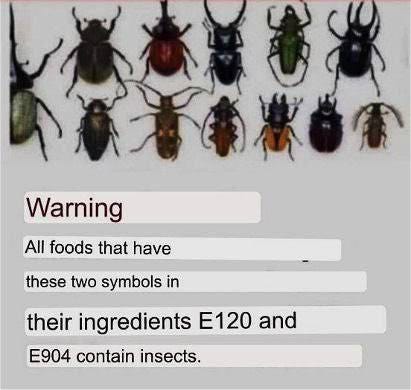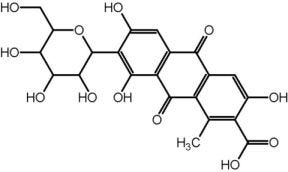Watch for Foods That Contain Insect Bodies (E120) or Secretions (E904)
E120 = Cochineal, Carmine, Carmines, Carminic Acid, C.I. 75470, C.I. Natural Red 4; E904 = Purified Lac Resin, Shellac, Confectioners Glaze. What's Wrong with This Picture?
By the time you read this article, you will know what is wrong with this picture:
Cochineal, Carmine, Carmines, Carminic Acid, C.I. 75470, C.I. Natural Red 4, or E120
Cochineal food additives come from crushed beetles. The beetles are sourced from either wild or farmed beetles, with some estimates showing up to 89 billion beetles are killed per year.
Carmine is a color pigment from the beetle bug Dactylopius coccus. It's natural habitat is cacti from the genus Opuntia, native to tropical Central and South America. Its red pigment is produced as a deterrent against other insects, and therefore also serves as an organic ant repellent. The pigment comes from the beetle’s trunk and eggs.
E120 is also used for its red color, used in some foods as a dye, and in red lipsticks and blushes. It takes about one thousand crushed beetles to make one tube of lipstick. If you haven't already, this might help you decide to ditch makeup, simply for this reason.
According to Food-info.net
Carmine is the name of the pigment; the actual colour is carminic acid (C22H20O13):
Structure 1 : Carmine
Cochineal is one of the few natural and water-soluble colorants that resist degradation with time. It is the most light- and heat-stable and oxidation-resistant of all the natural colorants and is even more stable than some synthetic food colours.
Cochineal it is neither toxic nor known to be carcinogenic. However, the dye can induce an anaphylactic-shock reaction in a small number of people, due to impurities in the preparation, not due to the carminic acid.
History
Cochineal was already used as a colour by the Aztec and Maya peoples of Central and North America. Cochineal was a commodity of much value, even comparable to gold. Cities send bags of cochineal to the capital Tenochtitlán as a yearly contribute to the emperor. The Spanish conquerors of Central America saw the value of the dye, which produced a much better colour than the dyes used in Europe at the time. The dye, which at the time was mainly used in cosmetics and textiles and to a lesser extend in foods, became very popular in Europe. Roman Catholic Cardinals robes were coloured with cochineal, as were the jackets of the British military. Cochineal was a highly prized product and was regularly traded on the London and Amsterdam Commodity Exchanges. As its origins were not known to most Europeans, the American colonists bought their cochineal from Europe, instead directly from Mexico.
In the 19th century the insects were imported and grown on a large scale on the Canary Islands and the Mexican monopoly came to an end. In 1868, the Canary Islands exported six million pounds of cochineal, equivalent to 420.000.000.000 insects.
In addition as a dye for textiles, cochineal became widely used as a food colouring. Cakes, cookies, beverages, jam, jelly, ice cream, sausages, pies, dried fish, yogurt, cider, maraschino cherries and tomato products were brightened with it as were chewing gum, pills and cough drops. Cosmetic rouge was developed with cochineal as the main ingredient. Cochineal is still widely used in cosmetics.
The demand for cochineal fell sharply with the appearance on the market of alizarin crimson and many other artificial (food and textile) dyes discovered in Europe in the middle of the 19th century. Trade in cochineal almost totally disappeared in the course of the 20thcentury, but in recent years it has become commercially valuable again as many producers (and consumers) prefer natural colours over synthetic colours. However, most consumers are unaware that the ‘natural colouring E120' refers to a dye that is derived from an insect. It is thus not suitable for vegetarians and is banned by some religions.
Production
The insects are killed by immersion in hot water (after which they are dried) or by exposure to sunlight, steam, or the heat of an oven. Each method produces a different colour which results in the varied appearance of commercial cochineal. The insects must be dried to about 30 percent of their original body weight before they can be stored without decaying. It takes about 155,000 insects to make one kilogram of cochineal.
There are two principal forms of cochineal dye: cochineal extract (E120(ii) ) is a colouring made from the raw dried and pulverised bodies of insects with around 20% carminic acid; and carmine (E120(i) ) a more purified colouring made from cochineal.
Source: http://www.food-info.net/uk/colour/cochineal.htm
Food Additives Regulation Note for the UK
A recent amendment to the Food Additives Regulation 1333/2008 means that we will no longer see the use of ‘cochineal’ on food labels in the EU and UK.
From 23 October 2019, food and drink manufacturers using the additive E120 in their products must use either of the terms ‘carminic acid’ or ‘carmines’; or the E number, E120 on their product labels. The term ‘cochineal’ must not be used and food labels will have to be updated. The Regulation also establishes new specifications for E120, including setting a maximum level for 4-aminocarminic acid at 3%, amending the Annex to Regulation (EU) No 231/2012. All products made after 23 October 2019 must comply.
Source: https://www.campdenbri.co.uk/news/cochineal.php
Uses of Carmines
The list of medications below is from Drugs.com
To color artificial flowers
Paints
Crimson ink
Rouge and other cosmetics
Fusion Plus Vitamin B Complex with C, Folic Acid, Iron and Probiotics
Source of medications: https://www.drugs.com/inactive/carmine-199.html
Purified Lac Resin, Shellac, Confectioners Glaze, or E904
Shellac is a natural resin that can also be derived from certain female Asian lac beetle secretions, after they feast on tree bark. The resin is harvested from beetle secretions that accumulate on the tree branches, which accumulates to form cocoons. Then it is heated and purified. Therefore, rather oddly, one can think of shellac as a bug product like that of honey from bees. It's not made of bugs; it's made of bug secretions.
The world's leading producer of shellac is India. Top consumers include the U.S, Europe, and Egypt.
Confectioners glaze is classified by the FDA as a GRAS food, "Generally Recognized As Safe." The USDA considers it to be an “organic” food, and followers of Judaism consider shellac a kosher food.
Foods Coated with Shellac
E904 is used to coat or glaze a food. It may be referred to as “confectioner’s glaze”, used to give candy that glossy shine seen on jelly beans, for example. If it's a shiny candy with a hard outer shell, it probably uses confectioner's glaze, with M&M’s being a notable exception. Foods using shellacc:
Chewing gums
Hard candies
Certain chocolates
Halloween candy corn
Easter jelly beans
UK Skittles (not USA Skittles)
Junior Mints
Sugar Babies
Whoppers
Milk Duds
Goobers
Raisinettes
Junior Mints
Other Shellac Coverings
Shellac coating makes pills easier to swallow, and any unpleasant odors can be covered up. Shellac coatings can also be used to cover fresh fruits or coffee beans as a wax. Other uses include as a covering on vitamins, supplement pills, and Big Pharma capsules.
According to the animal-rights organization PETA, it takes about one hundred thousand shellac bugs to make one pound of shellac flakes.
List of Medications Using Shellac
Some use shellac for imprinting letters on the pill.
Bronchitol
C Lax Laxative
Cariprazine
Entresto
Gentle Laxative Stimulant Laxative
Paracetamol
Motrin (Ibuprofen)
Tamsulosin
Wal Som Nighttime Sleep Aid
Multiple pill color coverings












God gave us common sense and an instinct for survival, which includes not eating bugs.
Health problems from eating bugs include allergies, as mentioned. Poisous insects would be deadly to eat.
As mentioned, small amounts of insects can trigger allergic reactions. People who are allergic to crustaceans are likely to be allergic to bugs - their skeletons are made of the same stuff. Dung beetles, burying beetles and woodlice all eat decaying matter, and allergic reactions have occurred.
Don't ever stop your information pipeline to us Dr. Aranda!
Godspeede!